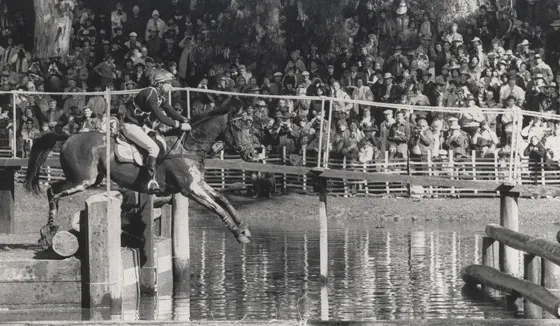While walking the two-star cross-country course at the Adequan FEI North American Junior and Young Rider Championships, our editorial intern, Ali Taylor Lange, and I came across a jump that had us scratching our heads. Clearly, it was not intended for the two-star riders, who might have cried a little upon approaching the massive creation.
“That has to be for the WEG,” I commented about the ginormous (yes, ginormous is a word) tree, complete with roots, that was cunningly laid on the backside of an equally ginormous ditch. Of course, most of you are thinking, “Oh, come on, it’s just a ditch and log,” but I’m telling you, this thing must have come straight off one of the Olympic courses from the 1950s. It screamed old-school eventing, and I got really excited!
Eventing is my personal favorite sport. I love them all, but the tomboy, adrenaline-junkie in me loves eventing above all else. Personally, I’ll never forget the way I felt crossing through the finish flags of cross-country for the first time.
Like most of our horse sports, eventing’s roots began in the military, where horses were the primary mode of transportation of men and equipment until the 20th century. Horses of every shape and size were used for war, depending on the style of warfare. Dressage, for example, started with the ancient Greek horseman Xenophon’s training methods and further developed during the Renaissance.
Since most cavalries needed horses that were versatile and well-schooled, a system of training was developed that tested the horses’ courage, elegance, stamina, training, power and grace. The horses were tested on the parade ground (dressage), on long marches (roads and tracks), jumping over distance on dispatch runs (cross-country) and in the arena (show jumping).
The beginnings of eventing as we know it today began in 1902 at the Championnat du Cheval d’Armes in France, and the sport became part of the Olympic Games in Stockholm, Sweden, in 1912. Sweden captured the first team gold medal. Axel Norlander and Lady Artist won the first individual gold for Sweden as well.
The format in 1912 was a little different than today’s typical event schedule—the endurance test happened on the first day, followed by steeplechase, jumping and finally, dressage. The competition lasted for five days, and horses had to carry 182 pounds.
ADVERTISEMENT
Of course, at that time, only active duty army officers were allowed to compete, and they had to be mounted on military horses.
The 1920 games saw the dressage phase removed, but it was brought back in 1924, where the classic or long format was introduced. This format consisted of:
Day 1: Dressage
Day 2: A) Roads and Tracks
B) Steeplechase
C) Roads and Tracks
D) Cross-Country
E) Run-In (This was a 1¼ mile run on the flat, and this phase was removed in 1967.)
Day 3: Show Jumping
In 1924, the newly dubbed “Three-Day Event” was open to civilians, but they weren’t allowed to compete in the Olympic Games until 1956. Women began competing in 1964.
Eventing was immensely popular in England, and the Badminton Horse Trials first ran in 1949. Interestingly enough, Badminton originally was open only to English combinations, but now they welcome international competitors as well. The Burghley Horse Trials began in 1961, and in 1978 the World Three-Day Event Championships were held at the Kentucky Horse Park—the first time these championships had been held in the United States. This led to the annual Rolex Kentucky Three-Day Event.
ADVERTISEMENT
The first civilian event held in the United States ran in 1949 alongside the Bryn Mawr Horse Show (Pa.), and in 1953 organizers decided to create a small-scale event based on the Olympic model. There was only one level at the time, and its success catapulted eventing’s popularity.
The sport remained similar to the 1924 event until 1963, when the 10-minute halt was added between phase C and D.
Horses had to carry a minimum weight for much of the sport’s history, but the weight rule was removed in 1997.
Of course, the sport underwent huge changes in 2004, when three of the four endurance phases were dropped, leaving only cross-country. The last long-format Olympic Games took place in 2000 in Sydney, Australia, and by 2006 most three-days were running in the new format. The debate still rages on within the United States about the change, with many riders carrying on the tradition in the form of national preliminary and training three-day events.
Eventing will take place at the WEG on Thursday, Sept. 30 – Sunday, Oct. 3. I know I’ll be glued to the action!
One of web writer Coree Reuter’s favorite parts of working at The Chronicle of the Horse is adventuring up into the attic. While it’s occasionally a journey that requires a head lamp, GPS unit and dust mask, nearly 75 years of the equine industry is documented in the old issues and photographs that live above the offices, and Coree is determined to unearth the great stories of the past. Inspired by the saying: “History was written on the back of a horse,” she hopes to demystify the legends, find new ones and honor the horses who have changed the scope of everyday life with this blog.
Curious about anything in particular? Have a question or an interesting topic? Please e-mail Coree, she’d love to hear from you!















